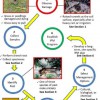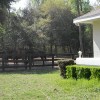 Mole crickets can become serious pests of turfgrasses, pastures, and vegetable seedlings. The first step in determining if you have a mole cricket problem at a site is to compare the existing damage to pictures of known mole cricket damage. If the damage is likely caused by mole crickets, specimens should be obtained and the pest identified. You then should determine if the number of mole crickets is great enough to cause an unacceptable level of damage and decide what control measures should be used. Eventually, a long-term, sustainable integrated pest management (IPM) program should be established. This 20-page guide will help you identify mole cricket infestations and manage them effectively and economically while minimizing environmental impacts. Written by C. R. Kerr, N. C. Leppla, E. A. Buss, and J. H. Frank, and published by the UF Department of Entomology and Nematology, May 2014.
Mole crickets can become serious pests of turfgrasses, pastures, and vegetable seedlings. The first step in determining if you have a mole cricket problem at a site is to compare the existing damage to pictures of known mole cricket damage. If the damage is likely caused by mole crickets, specimens should be obtained and the pest identified. You then should determine if the number of mole crickets is great enough to cause an unacceptable level of damage and decide what control measures should be used. Eventually, a long-term, sustainable integrated pest management (IPM) program should be established. This 20-page guide will help you identify mole cricket infestations and manage them effectively and economically while minimizing environmental impacts. Written by C. R. Kerr, N. C. Leppla, E. A. Buss, and J. H. Frank, and published by the UF Department of Entomology and Nematology, May 2014.
http://edis.ifas.ufl.edu/in1021
Tag: Norm Leppla
Pest Management Perceptions and Practices for Equine Farms in North and Central Florida (ENY2028/IN983)
 Equine facilities have unique pest management problems due to facility structure and horse husbandry practices. In Florida, homes on small equine farms are generally located in close proximity to pastures, stalls or run-in sheds, manure piles, and other fly breeding habitats. So homeowners have a high risk of exposure to pathogens that can be transmitted by filth flies to humans. Integrated pest management for equine farms requires accurate diagnosis of pest problems and the coordinated use of science-based management practices, but a recent survey shows that many equine property owners don’t know enough about the identification, biology, and presence of filth fly pests on their properties to develop successful IPM programs. This 7-page fact sheet was written by Erika T. Machtinger, Norman C. Leppla, and Cindy Saunders, and published by the UF Department of Entomology and Nematology, March 2013.
Equine facilities have unique pest management problems due to facility structure and horse husbandry practices. In Florida, homes on small equine farms are generally located in close proximity to pastures, stalls or run-in sheds, manure piles, and other fly breeding habitats. So homeowners have a high risk of exposure to pathogens that can be transmitted by filth flies to humans. Integrated pest management for equine farms requires accurate diagnosis of pest problems and the coordinated use of science-based management practices, but a recent survey shows that many equine property owners don’t know enough about the identification, biology, and presence of filth fly pests on their properties to develop successful IPM programs. This 7-page fact sheet was written by Erika T. Machtinger, Norman C. Leppla, and Cindy Saunders, and published by the UF Department of Entomology and Nematology, March 2013.
http://edis.ifas.ufl.edu/in983
Managing Thrips and Tospoviruses in Tomato (ENY859/IN895)
 Several invasive species of thrips have established in Florida and are causing serious economic losses to vegetable, ornamental, and agronomic crops. Damage to crops results from thrips feeding and egg-laying injury, by the thrips vectoring of plant diseases, the cost of using control tactics, and the loss of pesticides due to resistance. This 12-page fact sheet describes the biology and ecology of thrips and tomato spotted wilt virus, and recommends a management program. Written by Joe Funderburk, Stuart Reitz, Steve Olson, Phil Stansly, Hugh Smith, Gene McAvoy, Ozan Demirozer, Crystal Snodgrass, Mathews Paret, and Norm Leppla, and published by the UF Department of Entomology and Nematology, August 2011.
Several invasive species of thrips have established in Florida and are causing serious economic losses to vegetable, ornamental, and agronomic crops. Damage to crops results from thrips feeding and egg-laying injury, by the thrips vectoring of plant diseases, the cost of using control tactics, and the loss of pesticides due to resistance. This 12-page fact sheet describes the biology and ecology of thrips and tomato spotted wilt virus, and recommends a management program. Written by Joe Funderburk, Stuart Reitz, Steve Olson, Phil Stansly, Hugh Smith, Gene McAvoy, Ozan Demirozer, Crystal Snodgrass, Mathews Paret, and Norm Leppla, and published by the UF Department of Entomology and Nematology, August 2011.
http://edis.ifas.ufl.edu/in895
Integrated Pest Management Policy and Treatment Options for University Housing (IPM151/IN880)
The purpose of this manual is to train pest management technicians of the UF Department of Housing and Residence Education in integrated pest management (IPM). It includes the DOHRE IPM policy, specific IPM objectives, responsibilities of the DOHRE Senior IPM Technician, a flow chart of IPM actions, and requirements for using pesticides and associated recordkeeping. Pest-specific IPM options are provided for ants; bed bugs; bees and wasps; birds and bats; booklice, silverfish, and earwigs; cockroaches; flies; rodents; stored product pests; termites; and weeds. Selected references are provided, and there are forms for assuring service, pest surveillance, and record keeping. This 42-page training manual was written by Kevyn J. Juneau, Jennifer L. Gillett-Kaufman, Norman C. Leppla, Kirk W. Martin and A. Wayne Walker, and published by the UF Department of Entomology and Nematology, February 2011.
http://edis.ifas.ufl.edu/in880
IPM146/IN849 Guidelines for Purchasing and Using Commercial Natural Enemies and Biopesticides
IPM146, a 18-page illustrated fact sheet by Norman C. Leppla and Kenneth L. Johnson II, serves as a guide to select, purchase and use commercially available natural enemies and biopesticides to manage accurately diagnosed pest problems. It contains a list of sources and multiple tables with information about pest problems, available natural enemies and biopesticides, and commercial suppliers. Published by the UF Department of Entomology and Nematology, May 2010.
http://edis.ifas.ufl.edu/in849
IPM147/IN853 How to Use Nematac® S against Pest Mole Crickets in Pastures
Revised! IPM147, a 3-page illustrated fact sheet by N.C. Leppla, J.H. Frank, and J.A. Graesch, discusses the use of the proprietary formulation of insect-parasitic nematode Steinernema scapterisci for use against mole crickets, which can severely damage Florida pastures. Published by the UF Department of Entomology and Nematology, June 2010.
http://edis.ifas.ufl.edu/in853
ENY658/IN401 Managing Thrips in Pepper and Eggplant
Revised! ENY-658, a 6-page illustrated fact sheet by Joe Funderburk, Stuart Reitz, Phil Stansly, Dave Schuster, Greg Nuessly, and Norm Leppla, provides pepper and eggplant growers with management information for this serious pest of ornamental, vegetable and fruit crops in the field and greenhouse — biology and ecology, tomato spotted wilt and management programs. Includes references. Published by the UF Department of Entomology and Nematology, October 2009.
http://edis.ifas.ufl.edu/IN401